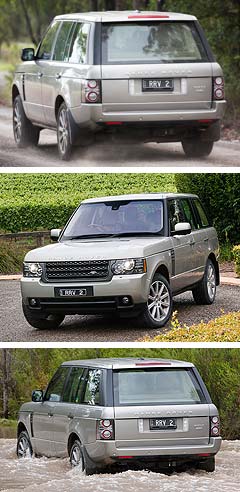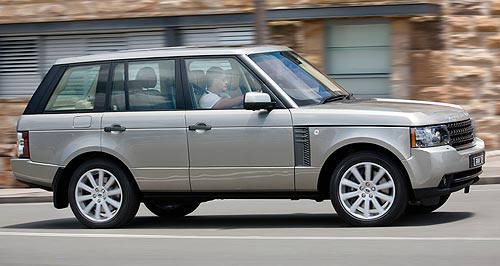New models - Land Rover - Range Rover - Vogue rangeFirst drive: Range Rover comes clean with big V8 dieselRange Rover: Diesel is in Vogue as luxury off-roader gets a makeover. Bigger diesel V8 cuts Range Rover Vogue thirst in 2011 revamp8 Feb 2011 THE 2011 Range Rover Vogue has arrived in Australia with a cleaner, more powerful and more efficient turbo-diesel V8 and greater refinement. Armed with 700Nm of torque, the 4.4-litre V8 powering the 2.5-tonne behemoth drinks just 9.4-litres of diesel per 100km, making the big-bore diesel the most efficient ‘Rangie’ ever. The arrival of the fresh Range Rover line-up – the last facelift of the current third generation before the all-new model descends in 2012 – signals the start of a big year for the Indian-owned (Tata), English-built Land Rover brand in this country, which is also launching a new Land Rover Freelander ahead of the debut of the Range Rover Evoque compact SUV that is expected to become the premium range’s volume selling model. The Range Rover Vogue will continue to be sold in Australia with a choice of three engines – a naturally aspirated 5.0-litre petrol V8, a supercharged version of that engine and a 4.4-litre twin-turbocharged diesel V8. It’s the later that has received the most attention in this update for 2011. The 2011 TDV8 comes with a price increase of around $5000 over the previous 3.6 TDV8, depending on which of the three specification levels are chosen, while the petrol V8 and V8 supercharged variants only rise by a few hundred dollars across the spec range. The TDV8 engine was introduced to the then already five-year-old, third-generation Range Rover back in 2007 when it replaced the BMW inline six-cylinder turbo-diesel. Back then, it was a 3.6-litre 90-degree V8 – developed exclusively for Range Rover – did not lack for anything. But in the quest for greater efficiency and reduced emissions, Land Rover has increased the capacity, dialed back the tune and introduced a host of new technologies, some of which have been derived from the 3.0-litre TDV6, that was already starting to encroach on the 3.6-litre V8’s performance, with 180kW and 600Nm. The new TDV8 was first shown in Europe mid-2010, slated exclusively for the Vogue, not for the Range Rover Sport like the 3.6 original.  It arrives here in the 2011 Vogue where it produces 230kW and 700Nm from its 4.4-litres, the larger capacity achieved with a both a larger bore and longer stroke over the 3.6. It arrives here in the 2011 Vogue where it produces 230kW and 700Nm from its 4.4-litres, the larger capacity achieved with a both a larger bore and longer stroke over the 3.6.More significant than the power and torque increases is the reduction in fuel use and emissions. Diesel consumption is down 18.5 per cent to 9.4 litres per 100km, making the TDV8 Vogue the most fuel-efficient Range Rover ever. CO2 emissions are down 14 per cent, from 294g/km to 253g/km, even though the TDV8 Vogue tips the scales at between 2580 and 2810kg. The 4.4 TDV8 has a lower specific output than the 3.6 and this ‘lower’ state of tune reduces harmful NOx emissions. The engine’s twin turbochargers are set up in a parallel sequential system just like those on the 3.0-litre TDV6 of the Discovery 4. In this configuration, a medium-sized, variable-geometry turbocharger works alone to force air into the engine under normal driving conditionsWhen the engine revs climb beyond 2400rpm, valves in the exhaust manifold open to allow flow to a smaller, secondary turbo that spins up to speed in just 20 milliseconds to give full boost from the pair of turbochargers in just 180 milliseconds with no evidence of lag. The smaller turbocharger is not in use when not required, thus improving engine efficiency by reducing pumping losses. New ceramic-tipped glow plugs heat up twice as fast as the traditional steel tips, allowing instant start up in normal temperature conditions. They are more durable too, allowing them to be kept on longer after start-up to help burn fuel more efficiently in a cold engine. They can also be activated more regularly for the same reason. Other improvements to enhance efficiency and reduce emissions include eight-hole piezo actuated fuel injectors – up from seven hole on the 3.0 TDV6 – exhaust gas recirculation, low ash engine oil, smart electrical charging system and a low-loss engine ancillaries drive belt. The most significant factor contributing to reduced fuel consumption is the all-new eight-speed automatic transmission from ZF. The 8HP70 transmission is one of the few available that are able to cope with the TDV8’s massive 700Nm torque while the eight speeds offer closer gear ratios over a wider spread to keep the engine at its most efficient operating revs. At idle, the transmission disengages 70-per cent of the drive to reduce load on the engine, using what Land Rover is calling Transmission Idle Control. On take off, the torque converter locks up at lower road speeds further reducing losses by using all the engine drive to propel the vehicle. Control of the eight-speed transmission is via a rotary dial for selecting Park, Reverse, Neutral, Drive or Sport modes. This does away with the traditional shift lever while manual gear shifting is available by using paddle levers behind the steering wheel. The drive selector dial mounts flush in the console but rises when the ignition is switched on, a la Jaguar. The Terrain Response dial has been replaced with a rocker switch further back on the console to avoid confusion between controls. This advanced transmission is the first eight-speed unit ever to be fitted to a Land Rover vehicle and is available only behind the TDV8 engine. The two petrol V8 engines retain the long serving but still slick six-speed 6HP28 ZF unit. The supercharged 5.0-litre V8 was new in 2010 and with 375kW and 625Nm on tap it delivers sledgehammer performance to this luxury suite on wheels. Zero to 100km/h clicks over in just 6.2 seconds on its way to a 225km/h top speed, and the massive Brembo brake package reigns it in just as quick. The naturally aspirated V8 delivers 267kW and 510Nm, so it also is no slouch, launching the heavy Rangie to 100 in 7.6 seconds. The TDV8 is the slowest over the 0-100km/h dash, taking 7.8 seconds. Land Rover’s excellent and now widely copied Terrain Response system has been revised on all 2011 Vogue variants, adding a Sand Launch Control, Gradient Acceleration Control and Hill Start Assist functions. These are within the existing five Terrain Response modes, which are activated by a switch, to aid the driver in off road conditions. Aside from the mechanical upgrades the Vogue remains relatively unchanged inside and out. It’s spacious interior retains the appearance a rolling gentleman’s club with acres of leather and timber paneling surrounding its occupants in utmost luxury, while isolating them from the conditions regardless of how far you care to venture off road. The inside an be optioned with premium audio systems, hard drive navigation, reclining, heated and cooled rear seats and a dual-view screen that allows different images to be viewed by the front-seat passenger and the driver. The third-gen Range Rover’s exterior design might be coming up on a decade old but it remains an elegant and powerful look that exudes style. For 2011, the Exterior Design Pack offers a revised front bumper with fog lamp surrounds, front grille and side vents in Titan finish, revised side sills, rear bumper and stainless steel exhaust tips. The Vogue is available in eight exterior colours. A replacement for the L322 Range Rover is due to surface in 2012 and be on sale in Australia late in that year or earlier 2013. Its all-new platform promises weight savings in all areas to further reduce fuel consumption and emissions and improve performance while retaining the high level of luxury set with the current vehicle.
 Quick testsRead more8th of February 2011  First drive: Land Rover freshens FreelanderNew TDI and cleaner petrol engines lift Freelander 2’s game for Land RoverRange Rover pricing
Motor industry news |
|
||||||||||||||

















Facebook Twitter Instagram